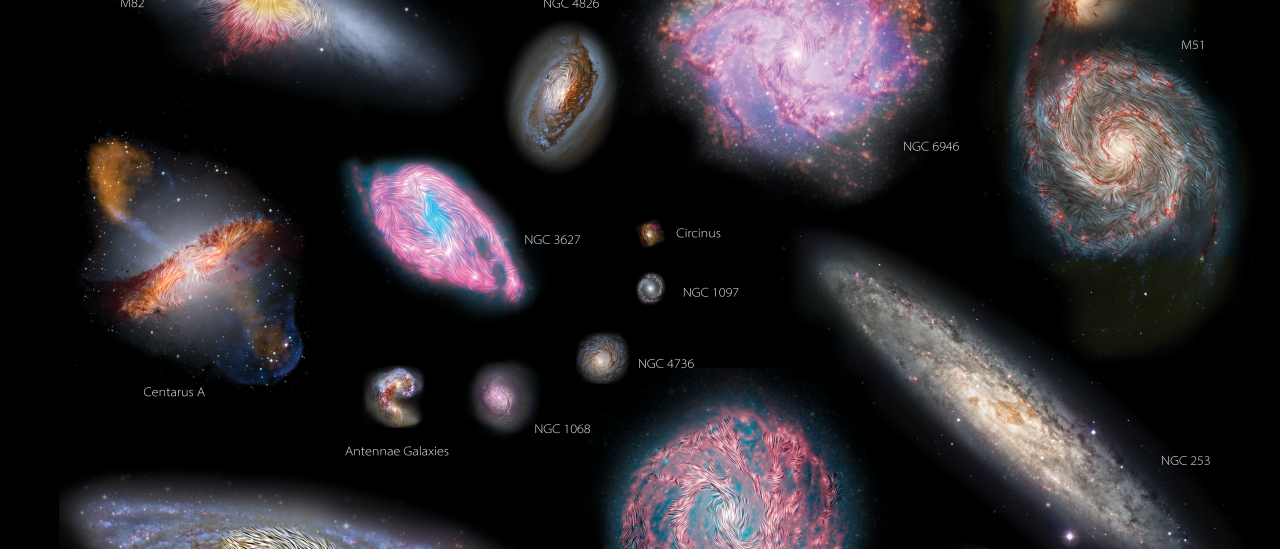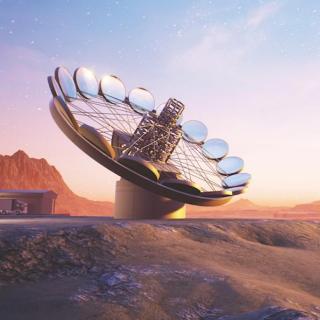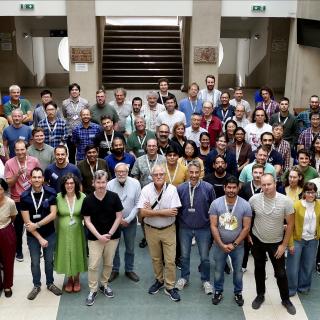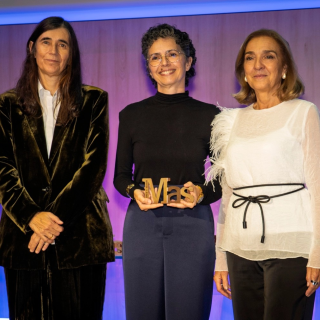International research, with the participation of the Instituto de Astrofísica de Canarias (IAC), reveals that perturbations in the magnetic fields of galaxies may be related to star formation. The study has mapped the magnetic fields of about fifteen galaxies in the vicinity of the Milky Way. The data were obtained with the HAWC+ instrument on board SOFIA, an airborne infrared telescope on a Boeing 747 that was operational until September 2022. The results are published in The Astrophysical Journal.
For decades, astronomers have studied the forces that govern the interior of galaxies - gravity, kinematic energy, stellar radiation, gas pressure - but magnetic fields are almost completely unknown. Magnetic fields may be a fundamental part of the evolution of galaxies, dragging interstellar gas towards the supermassive black hole, regulating the rate at which new stars form, influencing the formation of molecular gas clouds, and even affecting the internal kinematics of the disks of spiral galaxies.
Magnetic fields are intrinsically difficult to detect. While their field lines lurk between the stars and gas clouds that comprise galaxies, they do not emit any light on their own. So astronomers need to use specialized telescopes to detect their effects.
One of these instruments is HAWC+ (High-resolution Airborne Wideband Camera) on board SOFIA (Stratospheric Observatory for Infrared Astronomy), a joint project of NASA and the German Aerospace Center (DLR) consisting of a 2.7 m telescope mounted on a modified Boeing 747 aircraft, capable of flying over 99% of the Earth's atmosphere. HAWC+ is able to observe the far-infrared, polarized light emitted by magnetically aligned dust grains in galaxies and to infer the effects of magnetic fields deep in cold, dark molecular clouds.
Effects of star formation
An international team of scientists working on a project called SALSA (Survey on extragALactic magnetiSm with SOFIA) has used HAWC+ to observe 15 galaxies in the neighborhood of the Milky Way. They mapped the far-infrared magnetic fields and compared their structures with those obtained in the radio with the Very Large Array in New Mexico and the Radio Telescope Effelsberg in Germany.
The SALSA study has included starburst galaxies -galaxies forming stars at an incredibly high rate, often as a consequence of a recent galactic collision or other gravitational disruptions- and galaxies with active galactic nuclei, which are those that host a supermassive black hole emitting energetic jets of ionised gas.
The SALSA results reveal that the magnetic fields in turbulent, dense, star-forming clouds of gas are more disordered than those in diffuse interstellar gas traced by radio telescopes, a potential consequence related to the effects of star formation.
"For the first time we can study the magnetic field traced by interstellar dust grains, which emit polarised light because they are aligned by the magnetic field present in the interior of cold, dense molecular clouds. Results proves that magnetic fields are intrinsically related to star formation and that their amplification may be triggered by the very same processes that form new stars" explains Alejandro S. Borlaff, a researcher at NASA's Ames Research Center in California who led the study and obtained his PhD at the IAC.
SALSA results also show that SOFIA is more effective in tracing the magnetic field aligned parallel to the direction of these galactic outflows than radio telescopes. Radio telescopes, on the other hand, tend to be more sensitive to the magnetic fields present in the diffuse gas of the host galaxies.
"Different wavebands (far-infrared, radio) reveal different layers of the structure of magnetic fields. High-resolution, far-infrared polarization observations of galaxies such as those provided by SOFIA/HAWC+ until its last flight in September 2022 are vital to understanding the role of magnetic fields in the evolution of the Universe" says John Beckman, emeritus research professor at the IAC and the University of La Laguna (ULL), who participated in the study.
"It remains to be discovered how the magnetic field we observe in these nearby galaxies has come to be formed and amplified. Far-infrared observations with future space observatories or submillimetre observations with ALMA (Atacama Large Millimetre Array) can measure the magnetic fields in more distant galaxies, thus tracing the history of the magnetic field with the evolution of galaxies," concludes Enrique López Rodríguez, researcher at the Kavli Institute for Particle Astrophysics and Cosmology (KIPAC) at Stanford University and principal investigator of SALSA.
Article: Alejandro S. Borlaff et al: "Extragalactic magnetism with SOFIA (SALSA Legacy Program) -- V: First results on the magnetic field orientation of galaxies". The Astrophysical Journal, 2023. DOI: https://doi.org/10.48550/arXiv.2303.13586
Individual images of some galaxies studied by SALSA (Astronomy Picture of the Day):
- Centaurus A: https://apod.nasa.gov/apod/ap210421.html ,
- M51: https://apod.nasa.gov/apod/ap210120.html ,
- NGC1068: https://apod.nasa.gov/apod/ap191216.html ,
- M82: https://apod.nasa.gov/apod/ap190311.html
Contact at the IAC:
John Beckman, jeb [at] iac.es (jeb[at]iac[dot]es)
*Credits: M51: (NASA, the SOFIA science team, A. Borlaff; NASA, ESA, S. Beckwith (STScI) and the Hubble Heritage Team (STScI/AURA)); M82: NASA/SOFIA/E. Lopez-Rodriguez; NASA/Spitzer/J. Moustakas et al.; M83: NASA/JPL-Caltech/E. Lopez-Rodriguez; NGC 253: ESO/A.S. Borlaff; NGC 1068: NASA/SOFIA; NASA/JPL-Caltech/Roma Tre Univ.; NGC 1097: NASA, the SOFIA science team, E. Lopez-Rodriguez et al.; ESO/Prieto et al.; NGC 2146: ESA/Hubble & NASA/E. Lopez-Rodriguez; NGC 3627: NASA/JPL-Caltech/R. Kennicutt (University of Arizona) and the SINGS Team/E. Lopez-Rodriguez; NGC 4736: ESA/Hubble & NASA/A.S. Borlaff; NGC 4826: ESA/Hubble & NASA, J. Lee and the PHANGS-HST Team, Acknowledgement: Judy Schmidt/A.S. Borlaff; NGC 6946: ESA/Hubble/NASA/JPL-Caltech/L.Proudfit/A.S. Borlaff; NGC 7331: Adam Block/Mount Lemmon SkyCenter/University of Arizona/E. Lopez-Rodriguez; Antennae galaxies: ESA/Hubble & NASA/E. Lopez-Rodriguez; Centaurus A: Optical: European Southern Observatory (ESO) Wide Field Imager; Submillimeter: Max Planck Institute for Radio Astronomy/ESO/Atacama Pathfinder Experiment (APEX)/A.Weiss et al.; X-ray and Infrared: NASA/Chandra/R. Kraft; JPL-Caltech/J. Keene; SOFIA; Circinus:Andrew S. Wilson (University of Maryland); Patrick L. Shopbell (Caltech); Chris Simpson (Subaru Telescope); Thaisa Storchi-Bergmann and F. K. B. Barbosa (UFRGS, Brazil); and Martin J. Ward (University of Leicester, U.K.) and NASA/ESA/A.S. Borlaff. Poster design: NASA/SOFIA/L. Proudfit.




